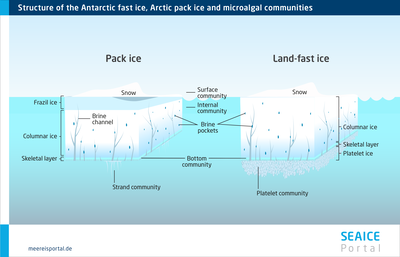Microalgae
The most visible group within the microbial sea-ice community are the single-celled microalgae, the ice algae. They are what often lend sea ice its characteristic brownish-green hue. The ice algae, as autotrophic organisms, are important for the marine ecology in both polar regions. Autotrophic organisms are life forms that exclusively produce what they need in order to build (and form organic reserves) from inorganic materials. They can use light and the naturally occurring substances in their surroundings to produce their own food (photosynthesis). Even if ice algae’s primary production through photosynthesis is quite low in comparison to that of their counterpart, the phytoplankton, in ice-covered regions the former are often virtually the sole source of fixed carbon for the higher trophic levels (Arrigo, 2017). That being said, recent studies have shown that under-ice phytoplankton blooms are a very common phenomenon in the Arctic (Ardyna et al., 2020).
The sea ice is home to an extraordinary number of algae species. Depending on the temperature, salinity, available light and food, in different places and at different times you will find different species of algae. As a rule, those species that have best adapted to current local conditions tend to dominate. Regardless, however, diatoms make up the vast majority of all ice algae (> 90 %). The diatom communities in the sea ice likely contain more than 500 species. It is generally assumed that the diversity of algae species is greater in the Arctic than in the Antarctic.
Many species in the Arctic belong to the single-celled genera Fragilaria, Cylindrotheca and Achnanthes. Another important species: the diatom Nitzchia frigida, which, as the most frequently encountered one, is a keystone organism in the Arctic’s seasonal ice all season long. In the Antarctic, the most important inhabitants of the seasonal ice are the large species Amphiprora, Pinnularia, Pleurosigma, Synedra and Tropidoneis. Thalassiosira, Porosira and Chaetoceros are round diatoms also found in sea ice, and tend to dominate in the newly formed sea ice or platelet ice of the Antarctic. Many species of diatom form cell structures from chains of individual cells. Some diatom species even form large structures that can extend centimetres, or even metres, from the underside of the sea ice into the seawater. In the Arctic, this applies to the species Melosira arctica; in the Antarctic, the most common thread-forming genus is Berkeleya, whose filaments can extend up to 15 centimetres below the ice. In addition to the diatoms, flagellates can be found in the sea ice of both polar regions: single-celled organisms with whip-like appendages used for locomotion. These include haptophytes, dinoflagellates, prasinophytes, chlorophytes (green algae), silicoflagellates, chrysophytes and cryptophytes (Arrigo, 2017).
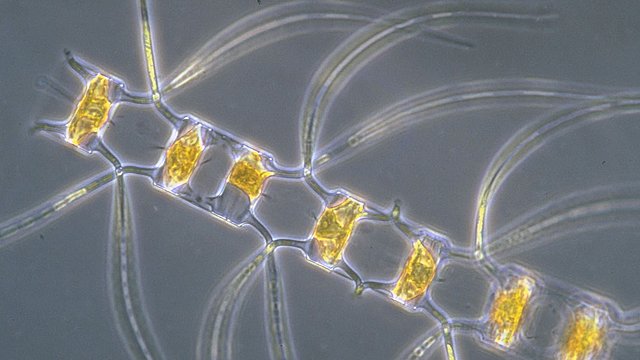
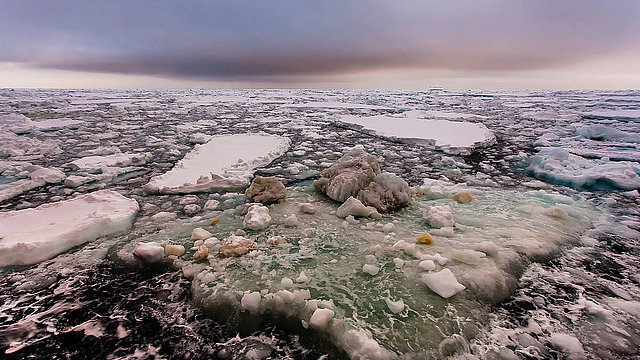
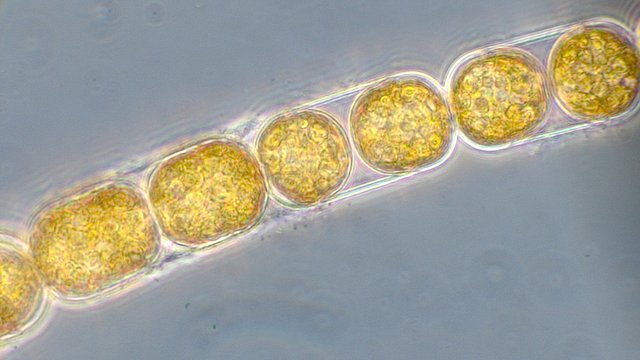
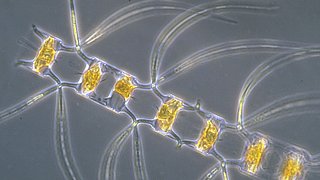
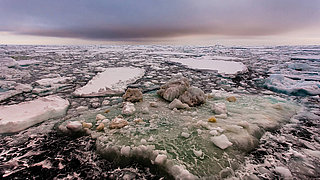
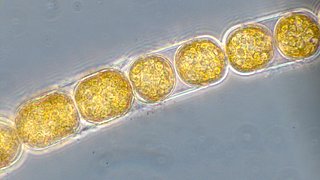
Algal biomass can be very unevenly distributed, as it is shaped by various factors, including temperature, salinity, light and available food. Ice algae grow particularly well in places where the sea ice is closely coupled with the ocean below it, since one of the most important factors influencing their growth are the nutrients constantly replenished by the ocean.
The available light, which can vary considerably, is equally important. Snow and thick layers of ice can reduce the amount of light penetrating the interior of the ice. Elsewhere, ice layers can overlap, producing a similar effect. In the Arctic, the salinity of the seawater is also determined by rivers from the mainland, which transport freshwater out to sea. The salinity of the sea ice, however, chiefly depends on the temperature and the age of the ice, and less on the salinity of the seawater it was formed from. The most important aspect is how much brine has already drained from the ice, and whether the ice was exposed e.g. to seawater flooding when the former was warm and porous.
Sea-ice algae mainly live in the bottom 20 cm of the sea ice, i.e., on its underside (bottom ice community), where the living conditions are generally more stable. The extent to which they spread upward from there is limited by the available food and the high salinity of the brine. Under certain conditions, ice algae can also be found in internal layers. These internal communities are associated with layers of frazil ice (free-floating ice crystals or wafers) or are found at the so-called freeboard level, where seawater can permeate the ice, providing the nutrients that ice algae need for growth. These conditions are more commonly found in the Antarctic than in the Arctic. The porous platelet ice, which is roughly 20 % ice and 80 % seawater in terms of volume, is home to the largest concentrations of ice algae (Arrigo, 2017). During the MOSAiC expedition, the existence of platelet ice in the Arctic was confirmed (Katlein et al., 2020).
Depending on the region and living conditions, the Arctic sea ice accounts for between 2 and 10 percent of total primary production; in the Antarctic, the number is between 2 and 24 percent (Arrigo, 2017). In the Arctic, the number rises to ca. 18 percent in the month of April, and to ca. 12 percent in May. Similarly, in November the sea ice accounts for ca. 4 percent of total primary production south of 50°S. For organisms living in the Arctic Ocean , the ice algae are particularly important for the time after the polar winter. Since they begin growing even with very little light, they offer an early food source for the zooplankton. As such, they fulfil a pivotal role in the Arctic food web. The ice algae blooms are most pronounced in late spring or early summer, i.e., when the ice begins to melt. Afterwards, the ice algae’s productivity tapers off: as the ice melts, the available habitat for the algae increasingly disappears, until they melt out of the ice and sink to lower depths. The ice algae mass also declines because the nutrients in the water are gradually depleted, and because zooplankton eat the algae. There can be a second wave of ice algae blooms in autumn, when the new sea ice forms, but tends to be short-lived.

Ice algae …
- can grow and reproduce extensively in just a short time, creating what are referred to as ice algae blooms. Ice algae blooms are an important component of polar food webs. They occur in spring, when sunlight increases and snow cover decreases, and occasionally in autumn. While the available light is what initiates blooms, nutrients are essential to maintaining the growth of sea-ice algae. These nutrients are gradually depleted, which can make them a limiting factor for algal growth, especially in the Arctic.
- use photosynthesis to convert dissolved inorganic carbon into organic material. Thanks to this primary production, they represent an essential element in the ecosystem, supplying energy for the entire food web. They are among the most important primary producers in the Arctic Ocean (Frey et al, 2020).
- form biomass-rich layers in the ice, offering a reservoir of nutrients for other organisms. Ice algae accumulate macronutrients and iron (bioaccumulation). When the ice melts, these nutrients are released. As a result, ice algae drive production in the ecosystem from an early phase of the year.
- use carbon dioxide (CO2) and inorganic nutrients to create organic biomass, and produce both dissolved organic carbon (DOC) and gelatinous biopolymers (extracellular polymer substances (EPSs)) in the sea ice.
Ardyna, M, et al. (2020): Environmental drivers of under-ice phytoplankton bloom dynamics in the Arctic Ocean. Elem Sci Anth, 8: 30. DOI: doi.org/10.1525/elementa.430
Arrigo, K.R. (2017): Sea ice as a habitat for primary producers, In: D.N. Thomas (ed.) Sea Ice, 3rd edition, Wiley-Blackwell, Chichester (UK) Hoboken (NJ), S. 352-369
Frey, K.E., J. C. Comiso, L. W. Cooper, J. M. Grebmeier, & L. V. Stock(2020): Arctic Ocean Primary Productivity: The Response of Marine Algae to Climate Warming and Sea Ice Decline, DOI: 10.25923/vtdn-2198; Arctic Report Card: Update for 2020; arctic.noaa.gov/Report-Card/Report-Card-2020/ArtMID/7975/ArticleID/900/Arctic-Ocean-Primary-Productivity-The-Response-of-Marine-Algae-to-Climate-Warming-and-Sea-Ice-Decline
Katlein, C., V. Mohrholz, I. Sheikin, P. Itkin, D. V. Divine & J. Stroeve et al. (2020): Platelet ice under Arctic pack ice in winter. Geophysical Research Letters, 47, e2020GL088898. doi.org/10.1029/2020GL088898

